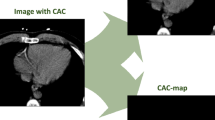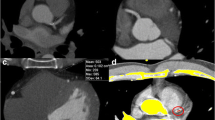Abstract
Cardiac calcium scoring is an important step for the diagnosis of coronary heart diseases. Therefore, non-contrast enhanced cardiac computed tomography has been established as the de facto standard method for clinical risk assessment and contrast enhanced computed tomography has proven to be a reliable, non-invasive alternative to traditional coronary angiography. However, calcium scores determined on contrast enhanced data cannot be easily related to the scores determined on non-contrast enhanced data. Hence, an increased number of studies are being performed in order to evaluate the clinical value of calcium scoring on contrast enhanced computed tomography coronary angiography images. While the clinical results with respect to the diagnostic value are promising, the high image contrast variability caused by the contrast agent leads to an increased manual effort in order to accurately segment calcified lesions in the data. Moreover, manual calcium scoring on contrast enhanced computed tomography scans is subject to strong intra- and inter-observer variability.
In this paper, we present a novel approach to the fully automatic segmentation and quantification of calcified lesions in coronary computed tomography angiograms. The method includes a robust threshold determination algorithm based on a histogram calculated from an automatically generated vessel tree. Thereby, lesions can be accurately segmented and calcium scores can be determined without user interaction. Validation against manual scores obtained by a radiologist showed a very high correlation, which demonstrates the clinical value of the presented method.
Similar content being viewed by others
References
Achenbach S (2007) Cardiac CT: state of the art for the detection of coronary arterial stenosis. J Cardiovasc Comput Tomogr 1:3–20
Agatston AS, Janowitz WR, Hildner FJ, Zusmer NR, Viamonte M, Detrano R (1990) Quantification of coronary artery calcium using ultrafast computed tomography. J Am Coll Cardiol 15:827–832
Bland JM, Altmann DG (1999) Measuring agreement in method comparison studies. Stat Methods Med Res 8:135–160
Budoff MJ, Achenbach S, Blumenthal RS, Carr JJ, Goldin JG, Greenland P, Guerci AD, Lima JAC, Rader DJ, Rubin GD, Shaw LJ, Wiegers SE (2006) Assessment of coronary artery disease by cardiac computed tomography: a scientific statement from the American heart association committee on cardiovascular imaging and intervention, council on cardiovascular radiology and intervention, and committee on cardiac imaging, council on clinical cardiology. Circulation 114:1761–1791
Deschamps T, Cohen L (2001) Fast extraction of minimal paths in 3D images and applications to virtual endoscopy. Med Image Anal 5(4)
Glodny B, Helmel B, Trieb T, Schenk C, Taferner B, Unterholzer V, Strasak A, Petersen J (2009) A method for calcium quantification by means of CT coronary angiography using 64-multidetector CT: very high correlation with agatston and volume scores. Eur Radiol 19:1661–1668
Grady L (2006) Fast, Quality, Segmentation of large volumes—isoperimetric distance trees. In: Leonardis A, Bischof H, Pinz A (eds) Computer vision—ECCV 2006. Lecture notes in computer science, vol 3. Springer, Graz, pp 449–462
Gülsün MA, Tek H (2008) Robust vessel tree modeling. In: Proc MICCAI, pp 602–611
Hadamitzky M, Freißmuth B, Meyer T, Hein F, Kastrati A, Martinoff S, Schöning A, Hausleiter J (2009) Prognostic value of coronary computed tomographic angiography for prediction of cardiac events in patients with suspected coronary artery disease. Int J Cardiovasc Imaging 2(4):404–411
Hoffmann MHK, Shi H, Schmitz BL, Schmid FT, Lieberknecht M, Schulze R, Ludwig B, Kroschel U, Jahnke N, Haerer W, Brambs H, Aschoff AJ (2005) Noninvasive coronary angiography with multislice computed tomography. JAMA 293(20):2471–2478
Komatsu S, Hirayama A, Omori Y, Ueda Y, Mizote I, Fujisawa Y, Kiyomoto M, Higashide T, Kodama K (2005) Detection of coronary plaque by computed tomography with a novel plaque analysis system, ‘plaque map’, and comparison with intravascular ultrasound and angioscopy. Circ J 69(1):72–77
Li H, Yezzi A (2007) Vessels as 4-D curves: global minimal 4-D paths to extract 3-D tubular surfaces and centerlines. IEEE Trans Med Imaging 26(9):1213–1223. doi:10.1109/TMI.2007.903696
Meijboom WB, Meijs MF, Schuijf JD, Cramer MJ, Mollet NR, van Mieghem CA, Nieman K, van Werkhoven JM, Pundziute G, Weustink AC, de Vos AM, Pugliese F, Rensing B, Jukema JW, Bax JJ, Prokop M, Doevendans PA, Hunink MG, Krestin GP, de Feyter PJ (2008) Diagnostic accuracy of 64-slice computed tomography coronary angiography: a prospective, multicenter, multivendor study. J Am Coll Cardiol 52(25):2135–2144. doi:10.1016/j.jacc.2008.08.058
Rinck D, Krüger S, Reimann A, Scheuering M (2006) Shape-based segmentation and visualization techniques for evaluation of atherosclerotic plaques in coronary artery disease, vol 6141. SPIE, Berlin, p 61410G. doi:10.1117/12.653248, URL http://link.aip.org/link/?PSI/6141/61410G/1
Saur SC, Alkadhi H, Desbiolles L, Szekely G, Cattin PC (2008) Automatic Detection of Calcified Coronary Plaques in Computed Tomography Data Sets. In: Proc of MICCAI. Lecture notes in computer science, vol 5241. Springer, Berlin, pp 170–177
Tek H (2008) Automatic coronary tree modeling. The MIDAS journal—grand challenge coronary artery tracking (MICCAI 2008 workshop). http://hdl.handle.net/10380/1426
Teßmann M, Vega-Higuera F, Fritz D, Scheuering M, Greiner G (2009) Multi-scale feature extraction for learning-based classification of coronary artery stenosis, vol 7260. SPIE, Berlin, p 726002. doi:10.1117/12.811639, URL http://link.aip.org/link/?PSI/7260/726002/1
Teßmann M, Vega-Higuera F, Bischoff B, Hausleiter J, Greiner G (2010) Robust automatic calcium scoring for ct coronary angiography. In: Bildverarbeitung für die Medizin 2010—Algorithmen, Systeme, Anwendungen (Informatik Aktuell). Springer, Berlin, pp 430–434
Toumoulin C, Boldak C, Garreau M, Boulmier D (2003) Coronary characterization in multi-slice computed tomography. In: IEEE Comp Cardiol, pp 749–752
Wesarg S, Khan MF, Firle EA (2006) Localizing calcifications in cardiac CT data sets using a new vessel segmentation approach. J Digit Imaging 19(3):249–257
Wilson PWF, D’Agostino RB, Levy D, Belanger AM, Silbershatz H, Kannel WB (1998) Prediction of coronary heart disease using risk factor categories. Circulation 97:1837–1847
Author information
Authors and Affiliations
Corresponding author
Rights and permissions
About this article
Cite this article
Teßmann, M., Vega-Higuera, F., Bischoff, B. et al. Automatic detection and quantification of coronary calcium on 3D CT angiography data. Comput Sci Res Dev 26, 117–124 (2011). https://doi.org/10.1007/s00450-010-0131-3
Published:
Issue Date:
DOI: https://doi.org/10.1007/s00450-010-0131-3




